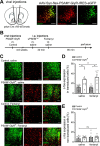Excitation of medium spiny neurons by 'inhibitory' ultrapotent chemogenetics via shifts in chloride reversal potential
- PMID: 33822716
- PMCID: PMC8024007
- DOI: 10.7554/eLife.64241
Excitation of medium spiny neurons by 'inhibitory' ultrapotent chemogenetics via shifts in chloride reversal potential
Abstract
Ultrapotent chemogenetics, including the chloride-permeable inhibitory PSAM4-GlyR receptor, were recently proposed as a powerful strategy to selectively control neuronal activity in awake, behaving animals. We aimed to validate the inhibitory function of PSAM4-GlyR in dopamine D1 receptor-expressing medium spiny neurons (D1-MSNs) in the ventral striatum. Activation of PSAM4-GlyR with the uPSEM792 ligand enhanced rather than suppressed the activity of D1-MSNs in vivo as indicated by increased c-fos expression in D1-MSNs and in vitro as indicated by cell-attached recordings from D1-MSNs in mouse brain slices. Whole-cell recordings showed that activation of PSAM4-GlyR depolarized D1-MSNs, attenuated GABAergic inhibition, and shifted the reversal potential of PSAM4-GlyR current to more depolarized potentials, perpetuating the depolarizing effect of receptor activation. These data show that 'inhibitory' PSAM4-GlyR chemogenetics may activate certain cell types and highlight the pitfalls of utilizing chloride conductances to inhibit neurons.
Keywords: D1 medium spiny neuron; PSAM; chemogenetics; chloride permeability; mouse; neuroscience; uPSEM.
Conflict of interest statement
SG, MO, AB, KM No competing interests declared
Figures






Similar articles
-
Modulation of cardiomyocyte contractility and action potentials with chemogenetic chloride currents.J Physiol. 2025 Mar;603(6):1399-1415. doi: 10.1113/JP286428. Epub 2025 Feb 24. J Physiol. 2025. PMID: 39992007 Free PMC article.
-
Dopaminergic treatment weakens medium spiny neuron collateral inhibition in the parkinsonian striatum.J Neurophysiol. 2017 Mar 1;117(3):987-999. doi: 10.1152/jn.00683.2016. Epub 2016 Dec 7. J Neurophysiol. 2017. PMID: 27927785 Free PMC article.
-
High ethanol sensitive glycine receptors regulate firing in D1 medium spiny neurons in the nucleus accumbens.Neuropharmacology. 2019 Dec 1;160:107773. doi: 10.1016/j.neuropharm.2019.107773. Epub 2019 Sep 12. Neuropharmacology. 2019. PMID: 31521620 Free PMC article.
-
D1 and D2 dopamine-receptor modulation of striatal glutamatergic signaling in striatal medium spiny neurons.Trends Neurosci. 2007 May;30(5):228-35. doi: 10.1016/j.tins.2007.03.008. Epub 2007 Apr 3. Trends Neurosci. 2007. PMID: 17408758 Review.
-
Seizing Control of Neuronal Activity: Chemogenetic Applications in Epilepsy.Epilepsy Curr. 2022 Sep 19;22(5):303-308. doi: 10.1177/15357597221120348. eCollection 2022 Sep-Oct. Epilepsy Curr. 2022. PMID: 36285203 Free PMC article. Review.
Cited by
-
Modulation of cardiomyocyte contractility and action potentials with chemogenetic chloride currents.J Physiol. 2025 Mar;603(6):1399-1415. doi: 10.1113/JP286428. Epub 2025 Feb 24. J Physiol. 2025. PMID: 39992007 Free PMC article.
-
Applications of chemogenetics in non-human primates.Curr Opin Pharmacol. 2022 Jun;64:102204. doi: 10.1016/j.coph.2022.102204. Epub 2022 Mar 17. Curr Opin Pharmacol. 2022. PMID: 35307295 Free PMC article. Review.
-
Chemogenetics as a neuromodulatory approach to treating neuropsychiatric diseases and disorders.Mol Ther. 2022 Mar 2;30(3):990-1005. doi: 10.1016/j.ymthe.2021.11.019. Epub 2021 Dec 1. Mol Ther. 2022. PMID: 34861415 Free PMC article. Review.
-
A humanized chemogenetic system inhibits murine pain-related behavior and hyperactivity in human sensory neurons.Sci Transl Med. 2023 Oct 4;15(716):eadh3839. doi: 10.1126/scitranslmed.adh3839. Epub 2023 Oct 4. Sci Transl Med. 2023. PMID: 37792955 Free PMC article.
-
Neuronal circuitry for recognition memory of object and place in rodent models.Neurosci Biobehav Rev. 2022 Oct;141:104855. doi: 10.1016/j.neubiorev.2022.104855. Epub 2022 Sep 8. Neurosci Biobehav Rev. 2022. PMID: 36089106 Free PMC article. Review.
References
-
- Al-Hasani R, McCall JG, Shin G, Gomez AM, Schmitz GP, Bernardi JM, Pyo CO, Park SI, Marcinkiewcz CM, Crowley NA, Krashes MJ, Lowell BB, Kash TL, Rogers JA, Bruchas MR. Distinct subpopulations of nucleus accumbens dynorphin neurons drive aversion and reward. Neuron. 2015;87:1063–1077. doi: 10.1016/j.neuron.2015.08.019. - DOI - PMC - PubMed
Publication types
MeSH terms
Substances
Grants and funding
LinkOut - more resources
Full Text Sources
Other Literature Sources
Molecular Biology Databases
Research Materials

